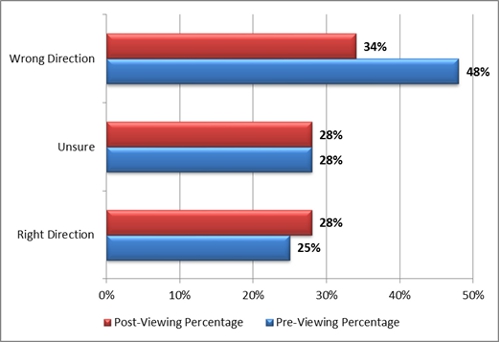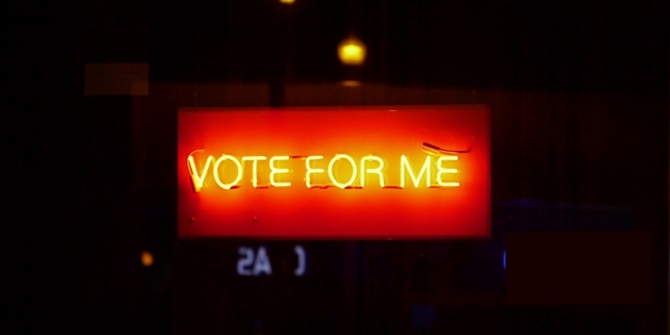 While government is frequently the subject of feature films, we have only a limited understanding on how government’s portrayal on films affect audience’s perceptions of state institutions. In new research, Michelle C. Pautz looked at the impact of two recent films, Argo and Zero Dark Thirty, on audience’s perceptions of government. She finds that after viewing the two films, many of the study participants’ views changed, with most expressing greater levels of trust in government and having a more positive view of government performance.
While government is frequently the subject of feature films, we have only a limited understanding on how government’s portrayal on films affect audience’s perceptions of state institutions. In new research, Michelle C. Pautz looked at the impact of two recent films, Argo and Zero Dark Thirty, on audience’s perceptions of government. She finds that after viewing the two films, many of the study participants’ views changed, with most expressing greater levels of trust in government and having a more positive view of government performance.
Film is arguably the most accessible form of art to Americans. Watching a movie occupies our senses more than any other form of art, particularly when we experience it at our local Cineplex. Regardless of its content, film has the power to shape perceptions of moviegoers on a range of subjects from love and marriage to the work of government. A frequent subject on the silver screen is government, yet our understanding of its influence is limited. With the prevalence and accessibility of film today, how does film affect the audience’s perceptions of government?
Two recent films, Argo and Zero Dark Thirty, were chosen as case studies to explore how Hollywood portrays the intelligence community in film and influences opinions about government more generally. Although this is exploratory research, the results demonstrate that anywhere from a fifth to a quarter of viewers changed their responses to a variety of questions about government after watching one of the films. Frequently, changes in responses indicated improvement in those opinions. These changes are interesting to note after just a few hours watching one movie.
With an interest in how film influences its audience, both Argo and Zero Dark Thirty make for great selections as both films chronicle the efforts of civil servants within the CIA during significant events in American history. Tony Mendez (portrayed by Ben Affleck), in Argo, orchestras an impressive ruse in creating—with the help of Hollywood insiders—a faux production company and uses it as cover to successfully get six Americans out of Tehran. Maya (portrayed by Jessica Chastain) is the relentless CIA analyst in Zero Dark Thirty who invests years tracking down Osama bin Laden and chasing leads that none of her colleagues think are worthwhile. She demands resources to track an individual that she suspects is bin Laden’s courier, and finally convinces skeptical leaders in the CIA and the White House that she has found bin Laden. Accordingly, the central character in both films is a government bureaucrat tasked with a seemingly impossible job in a highly volatile context, and both succeed.
For this study, participants were recruited from an undergraduate student population. Sixty-nine students watched one of the two films, and completed a questionnaire before and after the screening, with many of the questions repeated before and after watching. First, viewers were asked about their impressions of government generally. About half of participants, prior to watching one of the films, thought the nation was headed in the wrong direction whereas after watching, there are some noticeable differences. As indicated in Figure 1, post viewing, participants were more evenly split in their opinions about the direction of the country, with 38 percent indicating the country is headed in the right direction, 28 percent saying it is headed in the wrong direction, and 34 percent unsure.
Figure 1 – Assessment of direction of the nation

This change in response over a few short hours is interesting. Given current attitudes about the state of the country, it is unsurprising to see such a large portion of this study population think the nation is heading in the wrong direction, but it is noteworthy that the pessimism diminished considerably. Naturally, claims about the direct causality of movie watching and its effects on its audience cannot be made; nevertheless these findings are noteworthy. Furthermore, 22 percent of viewers demonstrated an improvement in their opinion after the movie about the direction of the country, whereas 76 percent held the same view, and only two percent noted a poorer assessment. Breaking down these data by the films, a quarter of Argo viewers reported an improvement in their assessment of the direction of the country whereas only 18 percent of Zero Dark Thirty viewers reported the same.
Additional questions inquired about viewers’ levels of trust in government. The majority of viewers both before and after the movie (51 percent and 60 percent, respectively) indicate that they trust government most or just about all of the time. After watching the movie, though, there was a bit of an increase in trust levels among viewers, as reflected in Figure 2.
Figure 2 – Viewers’ trust in government

A central component of this research is determining if there is any change in the opinions of viewers before and after watching either film. Overall, between a fifth and a quarter of the film audience in this study changed their opinions after watching either film. This may not appear to be a significant change, but consider for a moment that watching one film for a few hours resulted in changes of opinions of the viewers so imagine what a few films might do for one’s opinions. Figure 3 shows the percentage of viewers that changed their opinions about various questions after watching one of the films.
Figure 3 – Percentage of viewers with different opinions after viewing films

There is ample research that indicates films can influence their audiences and this research seems to find some support for those claims. More specifically, the study participants here reported the most change in their opinions of the U.S. military and general levels of trust in the government. Within these changes in opinions, the majority of shifts in opinions were for more positive opinions of government.
Although this research is limited because of its study population, there are a number of discussion points that could inform conversations about the effects of movies on their audiences and guide future research. First, the time period and event depicted in the film and the time in which the film is made and viewed might be important. A feasible argument may be made that the older the event, the less an audience remembers it or is familiar with the event beyond what may be learned in school. As a result, the film may have more of an ability to influence perceptions. The passage of time frequently clouds memories about the particulars of an event and how that event may impact our opinions about government, for instance. If we barely remember the complexities of a situation and how we responded to it at the time, its impact on our opinions may be subtler. And, if we were not even alive for seminal events, our ability to connect with those events and have those events influence us is much harder.
Second, another supposition from this research has to do with the necessary components of film as a medium for storytelling. Films that have a more distinctive characterization of characters and institutions might foster a greater influence on viewers. Put differently, if the “good guys” and “bad guys” are easier to determine, films might be able to influence their audiences. Given the confines of the medium—the narrative form, the timeframe, and the economic considerations—films tend to simplify stories and reduce plots and characters to more one-dimensional depictions. As a result, moviegoers often find themselves engrossed in stories that are constructed to work on the silver screen, observe allotted time limits, and appeal to audiences. These stories frequently depict obvious protagonists and antagonists, both in terms of individual characters and institutions; moreover, stories conducive to this medium often have definitive good and evil. This simplification is evident in both of the films considered here.
Finally, the results presented here might also inform broader conversations about how government is depicted on the silver screen. Film is one of the many factors that contribute to the political socialization of citizens. When considering how government fares in film, it is easy to conclude that film portrays government negatively, just as public opinion reflects. But the reality might be a bit more complex. Just as the relationship most Americans have with government could be described as a love-hate relationship, that complexity extends to film.
This article is based on the paper ‘Argo and Zero Dark Thirty: Film, Government, and Audiences’ in PS: Political Science and Politics, and was also discussed in a New York Times blog post.
Featured image credit: Janne Moren (Flickr, CC-BY-NC-SA-2.0)
Please read our comments policy before commenting.
Note: This article gives the views of the author, and not the position of USApp– American Politics and Policy, nor of the London School of Economics.
Shortened URL for this post: http://bit.ly/1KXk6os
_________________________________
 Michelle C. Pautz – University of Dayton
Michelle C. Pautz – University of Dayton
Michelle C. Pautz is an Associate Professor of Political Science at the University of Dayton. Her research interests are environmental policy and regulation, government reform and accountability, and film and politics.







This may be a late comment, but I really appreciate you using graphics to display research. I’ve looked through many different blogs and articles on this topic that do not have any. I sincerely appreciate it.